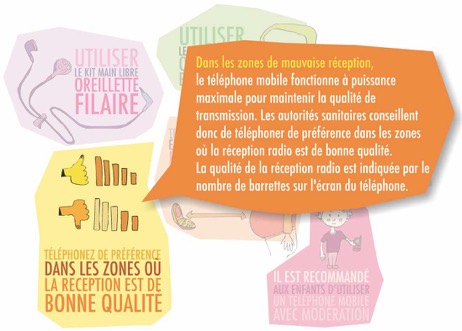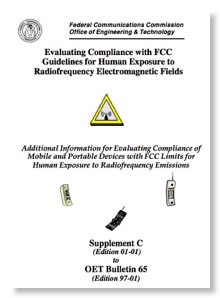Time Magazine on Cell Phone Safety: The Hidden OET Bulletin 65 Supplement C Problem
An article by columnist Mark Scherer entitled “Cell-Phone Safety: What the FCC Didn't Test” is in this week’s Time magazine. It points out
FCC testing regulations notably chose not to simulate a situation in which the phone was broadcasting at full power while inside a shirt or pants pocket flush against the body, an odd oversight given the known habits of many cellular-phone users. As a matter of physics, radio-frequency energy generally increases sharply as distance is reduced. "The exposure is definitely related to distance," says (retired FCC RF safety expert Robert) Cleveland.
The article is referring to the provisions in the somewhat obscure, but key for RF safety issues in cell phones, OET Bulletin 65, Supplement C (“OETB65C”) shown at left. This publication is not codified in the FCC rules and was last revised in January 2001, almost a decade ago. Whether or not the content of this publication made sense when it was adopted in 2001, a lot has changed since then in the use of the covered devices and new devices like my beloved iPod Touch, essentially a PDA with Wi-Fi, have become common.
The provisions Mr. Scherer was writing about are on p. 41-2 of OETB65C. They say:
Body-worn operating configurations should be tested with the belt-clips and holsters attached to the device and positioned against a flat phantom in normal use configurations. ... Both the physical spacing to the body of the user as dictated by the accessory and the materials used in an accessory affect the SAR produced by the transmitting device. ...Body-worn accessories may not always be supplied or available as options for some devices that are intended to be authorized for body-worn use. A separation distance of 1.5 cm between the back of the device and a flat phantom is recommended for testing body-worn SAR compliance under such circumstances. Other separation distances may be used, but they should not exceed 2.5 cm.
An phantom used for SAR measurements.
Simulated cavity is filled with special liquid
to simulate body’s electromagnetic qualities.
Cell phone tested is under body cavity.
The above quote from OETB65C essentially allows the device manufacturer to assume a distance from the body of 1.5-2.5 cm (0.59-0.98 inches) even if they do not provide any holder that keeps it that far from the body. Mr. Scherer describes this as “an odd oversight given the known habits of many cellular-phone users.” Someone who was involved in the writing of this document told me that it was not an “oversight”, but rather strong industry pressure on senior OET leadership at the time that resulted in the “apparent oversight”. Since this document was not written in a rulemaking, there is no paper trail and no transparency. Why determine the SAR limit in a rulemaking if you can nullify much of it in a document such as OETB65C?
Indeed, don’t a lot of people carry cell phones, Blackberries, and iPhones in their pockets? In view of the FCC’s recent interest to help inform the public about SAR by writing a whole consumer fact sheet entitled “SAR For Cell Phones: What It Means For You”, isn’t it odd that the need to maintain the same spacing as used in SAR testing is essential is never mentioned therein?
So suggestions for FCC to think about in this area:
- Maybe OETB65C, and the other parts of the OETB65 series, should be revised at least once a decade?
- Maybe the FCC/CGB fact sheet recently issued to explain SAR should also point out that the SAR measured to be in compliance with FCC rules is not meaningful unless the consumer actually uses the phone with the body separation that was assumed.
- As previously stated in this blog, maybe the FCC/CGB fact sheet should also point out that Blackberries/iPhones used in the “typing” mode are subject to a higher SAR limit of 4.0 W/kg so that there is a significant safety margin when they are used in this mode. SAR measurements in this mode are not normally made available to the public in a convenient form.
- FCC/CGB and CTIA might want to think about making more pragmatic information available about decreasing exposure from cell phones - it isn’t proven harmful, but it certainly isn’t doing you any good. The graphic below is from a web site operated not by a radical environmental group, but from AFOM - the French counterpart of CTIA. In this case it points out simply and clearly that cell phones operate at maximum power, hence maximum SAR, in areas with weak signals and that health authorities suggest using your phone in strong signal areas preferentially. Of course, carriers with poor signal coverage - and hence higher operating SARs in their customer’s phones - might prefer that the public not know this. However, a Bluetooth headset will reduce SAR even in this case.






![Validate my RSS feed [Valid RSS]](valid-rss-rogers.png)

